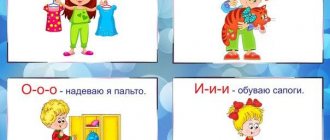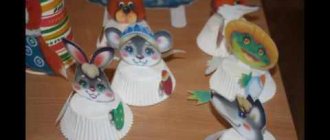card index of outdoor games “Movable Mathematics”
Description: Each player on the team is given one chip - a cap. You need to run to the landmark by completing tasks (bending around the pins, jumping over pigtails), and place the lid on the circle; you only need to put four caps in the circle.
Rules: complete the task quickly, run to the button, put the lid on correctly. The team that completed the task faster and more correctly wins.
Options: five caps per circle, six, seven,...
Relay "Skyscrapers"
Tasks: practice running with a task; consolidate the ability to group objects by a certain quantity.
Equipment: soft rings according to the number of children, 30 cm in diameter.
Description: Each child has a soft ring. You need to twist the ring on your hand, run to the landmark and put the ring in any column (four, five each) as indicated on the cards next to it.
Rules: run quickly, spin the ring without dropping it and place the ring according to the instructions. The team that completes the task faster and more correctly wins.
Relay "More by one"
Tasks: practice jumping and comparing numbers.
Equipment: cards with numbers, two for each child, numbers for the task.
Description: Children are formed into teams, each with a card with a certain number. You need to jump like a snake around the pins, on your left foot (2m), take a card with a number, one more, (according to the task) and jump back on your right foot.
Rules: Jump to the landmark on the left foot, back on the right foot. Be careful in completing the task. The team that completes the task faster and more correctly wins.
Relay "More, Less, Equal"
Objectives: Practice balance, jumping, and comparing sets using a mathematical sign.
Equipment: For two teams: gymnastic board, 4 pcs. braids, 2 pcs. landmark, scoreboard with team numbers - 4.
Description: Children are formed into teams. Each relay participant runs to the landmark on the gymnastics board, jumping over a moat of braids, flips through the board with numbers, stands between them and shows a sign with his hands.
Rule: quickly reach the landmark, having completed the task, correctly show the comparison. Go back and pass the baton with a clap on the hand.
Relay “Your Number”
Objectives: practice jumping on fitballs, consolidate the quantitative counting of objects and correlating it with a number.
Equipment: cards with a quantitative drawing for each child, cards with numbers, fitball - balls, landmarks.
Description: Each player is given cards with a quantitative design (five flowers, one butterfly, three bees,..), each team is given a fitball. You need to jump on the ball to the landmark and take a card with a number that matches your drawing.
Word games with a ball in math work with children
Word games with a ball in mathematics work with children.
Game "Where is the ball?"
Ball, ball, where are you lying? You won't run away from us. Goal: development of the ability to navigate in space, attention. strengthening the correct use of prepositions in children's speech.
Progress of the game. Option 1. Children perform a task with a ball: “Raise the ball above your head, place the ball at your right foot, place the ball on the carpet in front of you,” etc. Option 2. Children answer the question: “Where is the ball?” (on the table, on the floor, in the corner, near the table, under the table...) “Yesterday, today, tomorrow”
What was, what will be, Everyone remembers - will not forget. Goal: strengthening children’s ability to navigate time, developing attention, dexterity, imagination, phrasal speech. Progress of the game. The teacher throws the ball to everyone playing in turn, asking questions: Please answer me, What did you do yesterday? Did you do everything you wanted? What have you accomplished today? I also wanted to know - What will you do tomorrow? Children, returning the ball to the leader, answer questions. Option2. Sitting in a circle, children throw the ball to each other and talk about what happened to them yesterday, today and what they are going to do tomorrow. The content of stories can be both real and fictional.
Option3. The teacher throws the ball and says: “Today is Wednesday, and tomorrow?” Children, returning the ball to the leader, answer questions. "Morning afternoon Evening Night"
Morning, evening, day and night go away forever. Don’t rush to see them off, tell them what you did. Goal: strengthening children’s ability to navigate in time, fixing the names of the parts of the day, their sequence; development of attention, dexterity. Progress of the game. Throwing the ball in various ways (hitting the ball on the floor, rolling, passing the ball in a circle), the children answer the facilitator’s questions and tell what they did in the morning, during the day, and what they will do in the evening and at night. • What did you do this morning? • What did you do in the evening?
Options. 1. “Name the “neighbors” of the morning.” 2. “First it’s evening, and then?..” 3. “Name the missing word” (We have breakfast in the morning and lunch...) “Catch it, throw it, name the days of the week”
It was not in vain that we looked at the calendar - We all remember the days of the week. Goal: consolidation of temporary concepts in the child’s active vocabulary.
Progress of the game. Children stand in a circle. The teacher, throwing the ball to one of the children, can start on any day of the week: “I’ll start, you continue, name the days of the week!” Wednesday...” Children take turns throwing the ball to each other and sequentially calling out the days of the week.
Complication. Children and teacher stand in a circle. The teacher names the days of the week, slamming the ball on the floor for each word: “Monday. Tuesday..." Instead of the next day of the week, the teacher calls the child's name: "Sasha!" The child picks up the ball and continues, throwing the ball on the floor. You can also call the days of the week in reverse order. "Months and their sequence"
Month after month rises - Everyone will name them all. Goal: consolidation of temporary concepts in the child’s active vocabulary. Progress of the game. Children and teacher stand in a circle. The teacher and the children name the months by throwing the ball on the floor: “January, February, March...”. Instead of the next month, the teacher calls the child’s name: “Masha!” The named child picks up the ball and continues to name the months, slamming the ball on the floor. "Value"
What is wide (long, high, low, narrow)
Target. To clarify children's understanding of the size of objects, it teaches them to find the similarity of objects based on size.
Progress of the game. The teacher says: “The objects that surround us come in different sizes: large, small, long, short, low, high, narrow, wide. We saw many objects of different sizes. And now we’ll play like this: I’ll name one word, and you’ll list which objects can be called by this one word.” An adult has a ball in his hands. He throws it to the child and says the word.
For example: Adult: Long. Child: Road, tape, rope, etc.
"Let's count them"
Target. Securing the account: direct and reverse.
Progress of the game. The players stand in a circle, throw the ball to each other and call out the numbers in order. Nobody knows who the ball will be thrown to next.
Options:
1. We throw the ball to each other with the words “more than five.”
The one who caught it answers (7) and sets the task “less than eight.”
2. Throw the ball in a circle. The thrower calls any number.
The catcher names the neighbors of this number.
3. Let's enchant the ball for an action, for example, “+2”. The first player throws the ball and names a number within the first ten. The catcher must say how much it will be if 2 is added to this number, and throw the ball to another player, saying his number.
Nature word game with children.
"I'll ask and you'll answer"
Goal: consolidation of the material covered
Progress of the game: The teacher throws the ball to the child, asks a question, the child answers, throws the ball back to the teacher.
Option 1
An adult names a natural phenomenon, and a child names a season. For example:
-It’s snowing... (in winter);
-Rainbow in the sky... (in summer);
-Yellow and red leaves on the trees... (in autumn);
-The starling carries twigs to the birdhouse... (in spring); etc.
Option 2
The teacher names a generalizing word, and the children name words related to this meaning.
-Teacher: Insects are...
-Children:...fly, mosquito,...
-Educator: Pisces are...
-Children:.. crucian carp, pike,...
Option 2
-The teacher names a specific concept, and the children name a generalizing word.
-Teacher: A fly, a mosquito is...
-Children:...insects.
-Teacher: Goldfish, crucian carp is...
-Children:... fish.
"Say the word"
Goal: to develop auditory attention, to correctly select animals, birds, etc. etc., matching the description.
Progress of the game. The teacher reads the verse without finishing the last word, throws the ball to the child, who catches the ball and finishes the verse.
They can swim in the river for a day Restless….(ducks) “Moo and moo” Just one word Always speaks…..(cow) Guess who is nimbly Looking for crumbs, looking for grain? Speak, don’t be timid - This is a brave one..... (sparrow) For yellow-throated crumbs He carried midges all day, Caring father! His name is..... (starling) He doesn't like daylight.
Lives on the ground, digs and digs, digs and digs.
Every day he builds the metro...(mole) He takes up space in a puddle and lies on his side. The button resembles a pinkish snout... (pig) They hurry to their home, buzzing with concern. From gardens, from fields they bring sweetness, wax and aroma..... (bees)
“Throw the ball and name the animals”
Depending on the theme of the game, the following options are possible: “Throw the ball, clearly name the fruits” or “Throw the ball, quickly name the vegetables.” Goal: expansion of vocabulary through the use of generalizing words, development of attention and memory, ability to correlate generic and specific concepts. Progress of the game.
Option 1. An adult names a generalizing concept and throws the ball to each child in turn. The child, returning the ball to the adult, must name the objects related to this general concept. Adult: - Vegetables; Children: - Potatoes, cabbage, tomatoes, cucumbers, radishes, beets, carrots. Adult: - Fruits; Children: - Apple, pear, lemon, tangerine, orange, apricot. Adult: - Berries; Children: - Raspberries, strawberries, currants, lingonberries, blueberries, blackberries. Adult: - Trees; Children: - Birch, spruce, pine, oak, linden, poplar. etc. Option 2. The adult names specific concepts, and the child names generalizing words. Adult: Cucumber, tomato, turnip: Child: Vegetables. "Animals and their young"
Human children know all the animals in the world. Goal: to consolidate the names of baby animals in children’s speech, to consolidate word formation skills, to develop dexterity, attention, and memory. Progress of the game. When throwing the ball to the child, the adult names an animal, and the child, returning the ball to the teacher, names the baby of this animal. Basic movements: throwing the ball with a hit on the floor, throwing the ball; rolling the ball while sitting on the carpet. The words are arranged into three groups according to the method of their formation. The third group requires memorizing the names of the cubs. Group 1. for a tiger - for a lion - for an elephant - for a deer - for an elk - for a fox - Group 2. for a bear - a bear cub for a camel - a camel cub for a wolf - a cub for a hare - a cub for a rabbit - a cub for a squirrel - a cub for a cow - a horse's calf, a pig's foal - a sheep's piglet - a hen's lamb - a dog's chicken - a puppy Group 3. - tiger cub - lion cub - elephant calf - deer calf - fox calf "Who's talking like that?"
Catch the ball and quickly name the language of the animals. Goal: expanding vocabulary, developing reaction speed. Progress of the game. Option 1. An adult or presenter throws the ball to the children one by one, naming the animals. Children, returning the ball, must correctly answer how this or that animal gives a voice: cow tiger snake mosquito dog wolf duck pig moos growls hisses squeaks barks howls quacks grunts. Option 2. The teacher, throwing a ball to the child, asks: “Who is growling?”, “Who is mooing?”, “Who is barking?”, “Who is crowing?” etc. “Give me a word”
There is only one answer. Some people know, some don't. Goal: development of thinking, speed of reaction. Progress of the game. The teacher, throwing the ball to each child in turn, asks: “The crow is croaking, and what about the magpie?” The child, returning the ball to the teacher, must answer: “The magpie is chirping.” Examples of questions: - An owl flies, but what about a rabbit? - The cow eats hay, and the fox? - The mole digs holes, and the magpie? — The rooster crows, and the chicken? - The frog croaks, and the horse? - The cow has a calf, and the sheep? — The bear cub has a mother bear, and the baby squirrel? “Whose house?”
or “Who lives where?” Who is in the den, who is in the hole? Name it quickly! ' Goal: to consolidate children's knowledge about the homes of animals and insects. Consolidating the use of the grammatical form of the prepositional case with the preposition “in” in children’s speech. Progress of the game. Throwing the ball to each child in turn, the teacher asks a question, and the child returns the ball to the speech therapist and answers. Option 1. Educator: Children: Who lives in a hollow? Squirrel. Who lives in the birdhouse? Starlings. Who lives in the nest? Birds: swallows, cuckoo jays, etc. Who lives in the booth? Dog Who lives in the hive? Bees Who lives in a hole? Fox. Who lives in the den? Wolf Who lives in the den? Bear Option 2. Educator: Where does the bear live? Where does the wolf live? Children: In the den. In the lair. Option 3. Work on the correct sentence construction. Children are asked to give a complete answer: “The bear lives in a den.”
“What happens in nature?”
A person easily finds what happens in nature. Goal: to consolidate the use of verbs in speech, agreement of words in a sentence. Progress of the game. The teacher, throwing the ball to the child, asks a question, and the child, returning the ball to the teacher, must answer the question asked. It is advisable to play the game by topic. Example: Theme “Spring” Educator: Children The sun - what is it doing? It shines, it warms Ruchi - what are they doing? Running, murmuring Snow - what is it doing? It’s getting dark, the Birds are melting - what are they doing? They fly in, build nests, sing Kapel’s songs—what’s he doing? The Bear is ringing - what is he doing? He wakes up, leaves the den, “Who moves how?”
Who flies, who swims, who crawls, and who walks. Goal: enrichment of children’s verbal vocabulary, development of thinking, attention, dexterity. Progress of the game. The teacher, throwing the ball to the child, asks a question, the child, returning the ball to the teacher, must answer the question asked. The game is played with throwing the ball in different ways.
Educator: Do they fly? Children: Birds, butterflies, flies, dragonflies, mosquitoes, midges Teacher: Do they swim? Children: Fish, dolphins, whales, walruses, sharks
Educator: Do they crawl? Children: Snakes, caterpillars, worms
Educator: Are they jumping? Children: Grasshoppers, frogs, toads, fleas, hares.
“What actions do animals perform?”
or “What do animals do?” What can animals do - Birds, fish, cats, snakes? Goal: activation of children’s verbal dictionary, consolidation of knowledge about animals, development of imagination and dexterity. Progress of the game. The teacher, throwing the ball to each child in turn in different ways, names an animal, and the child, returning the ball to the teacher, utters a verb that can be attributed to the named animal.
Educator: Dog - Children Stands, sits, lies, walks, runs, sleeps, eats, barks, plays, bites, caresses, serves;
Cat (Purrs, meows, sneaks, laps, scratches, washes itself, licks itself);
Mouse (Rustles, squeaks, gnaws, hides, stores);
Duck (flies, swims, dives, quacks);
Crow (Flies, walks, croaks, pecks);
Snake (Crawls, hisses, wriggles, stings, attacks). “It happens - it doesn’t happen”
What will happen, what won't? Give me an answer quickly! Goal: expansion and consolidation of the child’s active vocabulary, development of logical thinking. Progress of the game. The players stand in a circle. The presenter calls the seasons. For example: "Summer". And then, throwing the ball to one of the children, he names a natural phenomenon. For example: “Ice drift”. The child who caught the ball must say whether this happens or not. The game goes in circles. Whoever makes a mistake leaves the game. Variants of natural phenomena and seasonal changes: frost, ice drift, drops, leaf fall, blizzard, frost, rain, snow, hail, thunderstorm, etc. Complication. Children give complete answers, explaining the possibility or impossibility of this or that natural phenomenon at a given time of year.
Game "Who was who?" We, of course, have not forgotten who you were yesterday. Goal: development of thinking, expansion of vocabulary, consolidation of case endings. Progress of the game. The teacher, throwing the ball to one of the children, names the animal, and the child, returning the ball to the teacher, answers the question of who the previously named object was: a chicken - an egg, a horse - a foal, a cow - a calf, an oak - an acorn, a fish - an egg, an apple tree is a seed, a frog is a tadpole, a butterfly is a caterpillar.
“Call it in one word”
Goal: to consolidate general concepts;
Progress of the game: The teacher names several objects, offers to name them in one word and throws the ball to the child. For example: “Magpie, crow, tit, sparrow, rook. Who is this?" The child answers the question and throws the ball to the adult.
Get text





